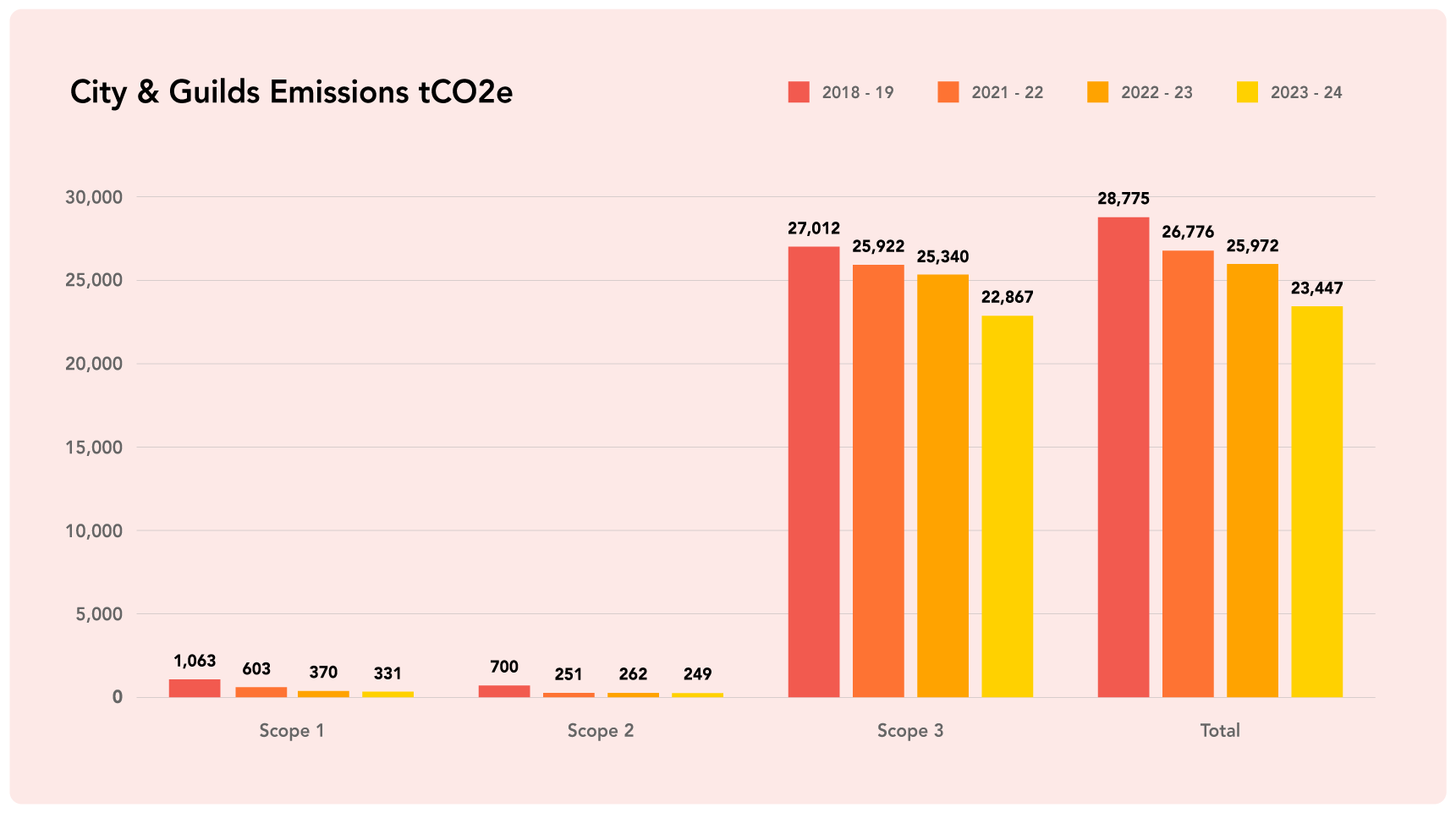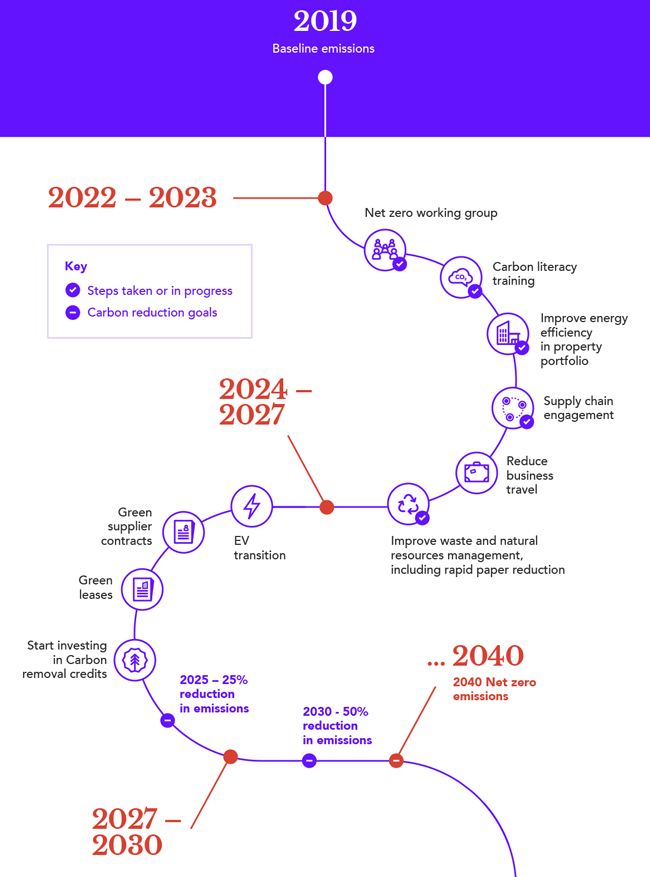Net Zero
At City & Guilds we are committed to net zero. Our ambition is to reduce
our carbon emissions by at least 50%
before 2030, and develop
environmentally responsible
operations to achieve net zero by
2040 or sooner if we can.
Our carbon footprint
We are pleased that our carbon footprint for 2023/24 shows a reduction of 9%, keeping us on the right track for targets under our Net Zero commitment and our wider Responsible Business strategy.

We have recorded the following progress in 2023/24
- 11% reduction in Scope 1 emissions (gas, fleet)
- 5% reduction in Scope 2 emissions (electricity)
- 10% reduction in Scope 3 emissions (supply chain)
In line with our long-term journey to Net Zero, in the past year we have:
- Convened a cross-organisational working group to support our Net Zero action plan
- Expanded the roll-out of our behavioural change programme (Carbon Literacy) across the organisation
- Improved our energy efficiency by switching to renewable energy for all the properties that we own
- Continued our review of internal procurement and contracting policies relating to ESG and Net Zero
Our net zero targets
- 2025 - 25%
- 2030 - 50%
- 2040 - 65%
Race to Zero
We are delighted to have joined the Race to Zero for Universities and Colleges, run by EAUC – the Alliance for Sustainability Leadership in Education, Second Nature and United Nations Environment Programme.

Our journey to net zero
This roadmap is the result of expert research and recommendations.
It is designed to keep us focused on high impact emission reductions and
on track until 2030. By then we will have reduced our greenhouse gas emissions
by 50% in line with climate science to limit global warming to 1.5°C or well
below 2°C, compared to pre-industrial levels.
We know all our colleagues and partners will play a key role in delivering these
recommendations, and their hard work and insights will help us continuously
develop and improve environmentally responsible operations to achieve
net zero by 2040 or sooner if we can.

Frequently asked questions
What is net zero?
Net zero means to completely negate the greenhouse gases (GHG) produced by human activity.
This is achieved by:
- reducing greenhouse gases emissions
- removing carbon dioxide from the atmosphere.
Science-based targets provide a clearly defined pathway to reduce greenhouse gas emissions, helping prevent the worst impacts of climate change and future-proof business growth.
Science-based targets require:
- reducing carbon emissions by half by 2030
- reach net zero by 2050 or sooner.
If this is not achieved, global warming will rise above 1.5°C creating devastating change to the climate as we know it. A 2018 study by the Intergovernmental Panel on Climate Change (IPCC) showed that temperatures could cross 1.5°C within a decade if global warning continues to increase at the current rate.
Under the Race to Zero initiative, a 50% reduction is required by 2030 with immediate action on environmental protection taken, and net zero to be reached by 2050 or sooner.
What is the Greenhouse Gas (GHG) Protocol?
The GHG Protocol is the global standard for measuring and managing greenhouse gas emissions.
It offers standards, tools and training to help businesses to measure and manage their GHG emissions. It provides guidelines and requirements to undertake GHG inventories and calculate carbon footprints.
A corporate carbon footprint is the total amount of GHGs that come from an organisation’s activities, including direct and indirect emissions (Scopes 1,2 and 3).
What does tCO2e mean?
There are six main greenhouse gases, so it's helpful to count them with a single unit: tCO2e. tCO2e stands for tonnes (t) of carbon dioxide (CO2) equivalent (e). Carbon dioxide equivalent is a standard unit for counting GHG emissions regardless of whether they’re from carbon dioxide or other GHGs, such as methane or nitrous oxide.
We have followed the GHG Protocol methodology to measure our carbon emissions.
Identifying and accurately calculating greenhouse emissions, especially those that occur in the value chain and are out of control (Scope 3), can be very challenging, as it is a complex and detailed task.
We have partnered with sustainability consultancy Green & Good to measure our GHG emissions and set our net zero pathway. Green & Good have helped us to measure and analyse our Scope 1, 2 and 3 emissions and define a fit for purpose net zero pathway. This tailored approach will support City & Guilds in making a successful transition to the net zero economy.
What is City & Guilds’ responsible business strategy?
At City & Guilds, we are committed to reducing our negative impacts on the environment and increasing our positive social impact by developing the skills needed to create a more sustainable world.
We believe that humanity’s race to net zero will only be won when people have the right technical and leadership skills.
We have always been here to meet the changing needs of industries, giving them confidence to invest in skills for success.
Our commitment to net zero is also a commitment to our customers and partners: to develop desirable green skills; open new opportunities; and make sure no business, community or individual is left behind.
Our approach to Responsible Business focuses on three areas where we have a significant impact: Planet, People and Product.
Find out more
Why are we committing to reducing our emissions by 65% to achieve net zero and why can’t we achieve it sooner?
The Science Based Targets Initiative (SBTi) is the leading net zero standard setter for for-profit corporates. The carbon emission reductions corporates are required to make are in line with the universally agreed science-based 1.5°C global warming scenario. The SBTi require businesses to make a 90% reduction in emissions from their baseline by 2050 or sooner.
We have thoroughly explored this scenario for City & Guilds. However, we have considered the costs of such deep emission reductions and have established that a 90% reduction target would not be achieved without significant changes to our business models, operations, and practices. Our approach is informed by expert research and anchored in the current economic, technological and policy context. A lot will change in the next 17 years, and we will adapt accordingly to do whatever we can to reduce our emissions as close to zero as possible.
For now, we want to be transparent, set achievable targets and stay away from unrealistic net zero claims.
We are therefore adopting a fair share approach for our net zero journey. We have joined the United-Nations-convened Race to Zero global initiative, committing to achieve a required 50% reduction in emissions by 2030 and a fair share approach to net zero by 2040 or sooner. This means that we will reduce our footprint by at least 65% by 2040. We will invest in high quality carbon removal methods for the remaining 35%. However, we will aways prioritise carbon emission reductions to limit the use of offsets.
What is fair share?
The concept of fair share within Race to Zero aims to recognise the complications for certain sectors over others. Extending the metaphor of a race, those who can run faster must do so.
The campaign has established a common starting line for credible climate ambitions and recognises that many actors have much further that they need to go, both on climate action and on other related areas of their operations. Some actors can and will race faster than others towards the finish line.
A ‘fair share’ requires that wealthy actors such as organisations and cities set a target to reduce absolute CO2 emissions by 50% by 2030 at the latest and strive to move significantly faster.
How did we establish our fair share targets?
We have established a mid-term target to 2030 and a net zero target of 2040. Net zero requires a significant reduction of GHG emissions and we are adopting a fair share approach (65%), rather than a 90-95% reduction required by SBTi due to the nature of our organisation and resources currently available.
We have determined fair share to be an achievable reduction to meet a ‘well-below’ 2°C scenario. We have based this a mid-point from the following guidance:
- A 1.5°C scenario based on the SBTi definition would require a mid-term 2035 target of 67.2% for Scopes 1,2 and 3
- A well-below 2°C for Scope 3 requires a target of 40% by 2035
Targets are considered science-based if they are in line with what the latest climate science deems necessary to meet the goals of the Paris Agreement – limiting global warming to well-below 2°C, preferably to 1.5°C, compared to pre-industrial levels.
Why does our net zero roadmap details actions up until 2030 and not 2040?
Our roadmap is designed to keep us focused on high impact emission reductions and on track until 2030. It’s very difficult to plan beyond this date. The world will change a lot in the next 17 years, with huge shifts in the energy markets, transport and policy.
What is Race to Zero?
Race to Zero is the UN-backed global campaign rallying non-state actors – including companies, cities, regions, financial, educational, and healthcare institutions – to take rigorous and immediate action to halve global emissions within this decade and deliver a healthier, fairer, zero carbon world in time to achieve the goals of the Paris Agreement.
All members are committed to race towards the same overarching goal: reducing emissions across all scopes swiftly and fairly in line with science, with transparent action plans, robust near-term and long-term targets, and annual reporting against their progress.
We are delighted to have joined the Race to Zero for Universities and Colleges, run by EAUC – the Alliance for Sustainability Leadership in Education, Second Nature and United Nations Environment Programme.

What is City & Guilds Environmental Policy?
Our commitments go beyond compliance and risk management; we believe that we have a unique responsibility to help deliver the Green Industrial Revolution’s promise of higher paid skilled jobs and sustainable growth for all. And we are creating a clear pathway that will engage our colleagues and suppliers not just to meet our targets but to be inspired and equipped to create new products for net zero, green and inclusive skills development.
This policy applies to all people working for City & Guilds in any capacity, and to our suppliers.
Read the Environmental Policy